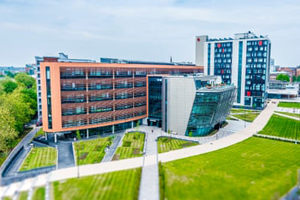Study In De Montfort University, De Montfort University course list, De Montfort University Fees, De Montfort University UK, Applying to De Montfort University? Get up-to-date about Study In De Montfort University UK, fees, De Montfort University course list, De Montfort University Ranking, De Montfort University Courses, De Montfort University Fees.
De Montfort University
Countries
Visitors
Visa Granted
Subjects
De Montfort University – Description
De Montfort University Leicester (DMU) is a public university in the city of Leicester, England. It was established in accordance with the Further and Higher Education Act in 1992 as a degree awarding body. The name De Montfort University was taken from Simon de Montfort, a 13th-century Earl of Leicester credited with establishing the first Parliament of England in 1265.
De Montfort University has approximately 27,000 full and part-time students, 3,240 staff and an annual turnover in the region of £168 million. The university is organised into four faculties: Art, Design, and Humanities (ADH); Business and Law (BAL); Health and Life Sciences (H&LS); and Computing, Engineering and Media (CEM). It is a Sustainable Development Hub, focusing on Peace, Justice and Strong Institutions, an initiative by the United Nations launched in 2018.
In 2019, the first Times Higher Education (THE) University Impact Rankings, a global performance tables that assess universities against the United Nations’ Sustainable Development Goals, ranked De Montfort University 50th in the world. The UK Department of Education awarded university a Gold rating in the 2017 Teaching Excellence Framework. It is a member of the Association of Commonwealth Universities.

campus
The university’s origins are in the Leicester School of Art, established in 1870 on a voluntary basis. The school expanded in response to the changing needs of late 19th-century industry; leading to the introduction of subjects such as engineering, building and machine drawing. By 1897, it was clear the buildings being used were no longer suitable. £25,000 was raised to build ‘a very handsome school that would be enormous credit to the town and … so that it would answer its purpose for the next 100 years’. The building in question is the Hawthorn Building, which today still houses the sciences; in the shape of the Faculty of Health and Life Sciences. At the time of the first phase its construction, there were 500 art students and 1,000 technical students. In 1903, a letter from His Majesty’s Inspector praised the success of the technical subjects. Increasing demand for courses prompted an extension to the Hawthorn Building in 1909. In 1919, further properties were rented. The Duchess of Atholl laid the foundation stone of Hawthorn’s new west wing in 1927; by which time the establishment was known under by the joint name of The Leicester Colleges of Art and Technology.
In 1930, the college was recognised for the external degree course in Pharmacy of the University of London, and the Pharmaceutical Chemist Diploma of the Royal Pharmaceutical Society of Great Britain. In 1934, the University of London recognised the college as suitable for preparing students for the External Degree in Engineering, and so the courses on offer developed apace. The prospectus for 1936–37 included details of various technically based schools, including the Schools of Architecture, Building and Building Crafts, and Engineering. The fourth phase of extensions to the Hawthorn Building was completed in 1938–39. The first accommodation was secured in 1946 when three houses were purchased by the university.
More space was needed to meet the academic demand, and so in 1948, Mr F. Bray, Under Secretary of the Ministry of Education, opened the converted Downings Warehouse. In 1966, the new Fletcher building was opened by HM The Queen Mother. In the same year, a white paper, “A Plan for Polytechnics and Other Colleges”, was published, leading to the creation of the City of Leicester Polytechnic. Under the provision of the Education Reform Act of 1988, Leicester Polytechnic became a Higher Education Corporation, with Dame Anne Mueller appointed Chancellor in June 1991.
Leicester Polytechnic became De Montfort University in accordance with the Further and Higher Education Act in 1992, establishing it as a degree awarding body in its own right. The name De Montfort University was taken from Simon de Montfort, a 13th-century Earl of Leicester credited with establishing the first parliament in 1265.
De Montfort University Course List
ELIGIBILITY CRITERIA IN GENERAL

COUNTRIES


